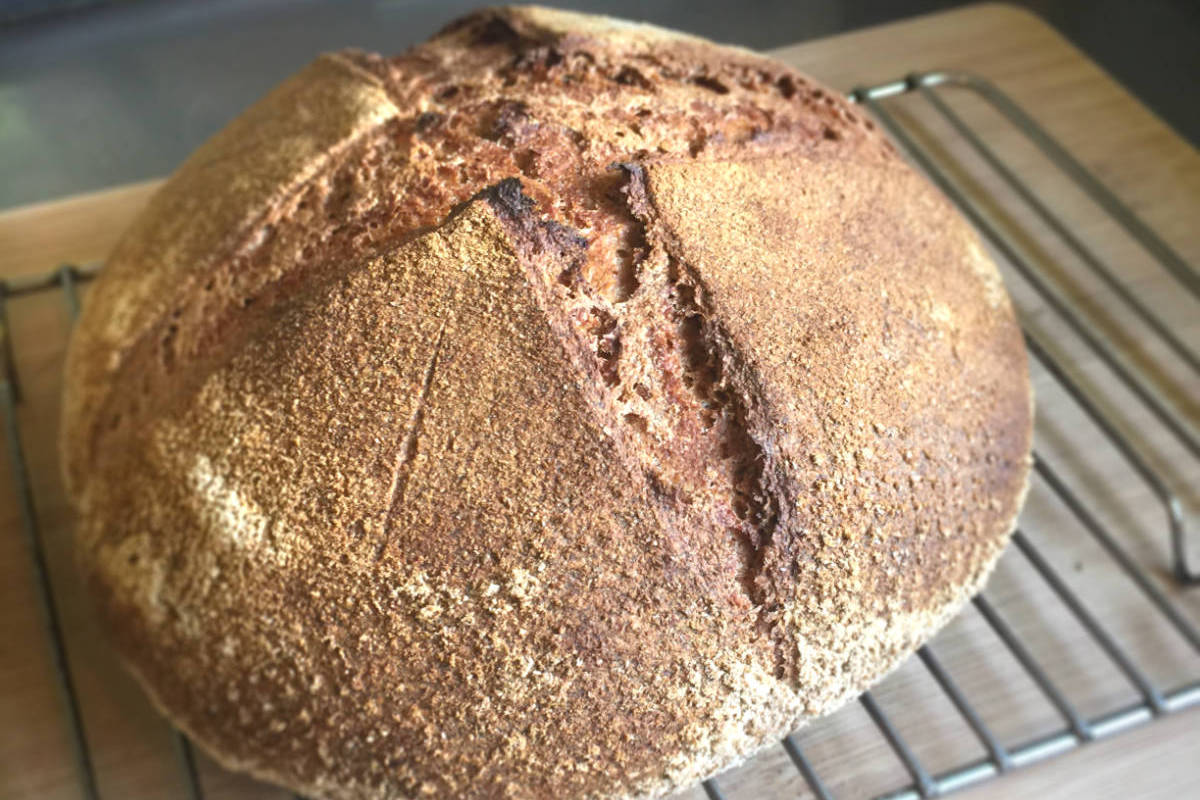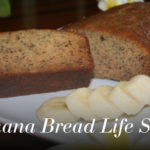One of the great things about baking no-knead bread without a dutch oven is that there is a vast amount of flexibility in how you bake, the tools you use, and the ingredients you select. By making some small changes, you can come up with very different results. This leaves us with a lot of room for creativity and fun.
No-knead bread, or no-knead sourdough, has become something of a sensation over the past months. And I have to say it was something that did not come easily to me. This recipe is honestly one of the reasons I ended up starting this blog.
One reason that there is so much flexibility in no-knead bread lies in the fact, maybe ironically, that there are so few ingredients. It’s one of those situations where because so little goes into it, so much can go wrong. But when you finally get a handle on the basics, a huge world of possibilities opens up. By slightly adjusting the amount of water, or salt, or time, we can end up with a dramatically different result. That’s pretty fun.
You can also make some significant changes in your results by adding one ingredient, such as rosemary or some other herb. However, I recommend sticking with the basics: water, flour, salt, and starter for your first several bakes.
Your baking environment
Probably the most important factor in the baking process here is your environment. This is the critical piece to begin to understand. Once you understand how this recipe behaves in your specific environment (heat, humidity, etc), you can do almost anything with it.
As someone baking in a tropical environment, the two most important factors that I’ve had to learn to deal with are heat and humidity.
How heat affects sourdough baking
Heat will dramatically affect the way that your sourdough starter behaves. I’ve noticed this mostly in the time that it takes to prove my loaves, but also in the texture I get from the crumb and crust.
As I was learning this process, I ruined many loaves simply because I was over-proving my bread…by a LOT! I didn’t understand how much my environment would change the proving process, and when my loaves came out hard, heavy, and dense it didn’t dawn on me that the weather was dictating the outcome…NOT the clock.

I thought, If the loaf is dense and heavy…it probably needs MORE proving time, right? Nope. Over-proving a loaf of sourdough bread will turn it into a hockey puck like no one’s business. Once I started watching the amount of rise I was getting, and more importantly trusting the rise, everything changed.
Tip: Use a clear glass bowl and apply a sticker to the level of the dough before it rises. It’s really easy to see when your dough has doubled or tripled when you have a reference point.
It’s often over 85 degrees in my kitchen…it can get to 90 pretty easily. The time it takes to get a good bulk rise is a lot shorter than if I was in a more temperate climate.
Get VERY comfortable with watching your dough and trusting the rise you see rather than clock watching according to a recipe or YouTube video.
How humidity affects sourdough bread
Heat and humidity are intertwined, but humidity can cause all kinds of issues if you’re not clear on how sticky or how smooth your dough “should” feel as you’re working it.
Humidity will directly affect the hydration of your dough. Just like it’s important to watch the rise you get instead of the clock, it’s crucial to examine the texture of your dough as you work with it. Get comfortable with adding more flour if you need it or letting it be a bit wetter if you have the skill to work with that kind of dough. It takes practice!
Also, realize that every loaf of bread does NOT need to be 80% hydration to be soft and creamy. Make sure to experiment and learn as you go.
Methods and tools
No-knead bread without a dutch oven…in a pan.
This is my favorite way to make a quick, delicious sourdough loaf that my family can use for sandwiches, toast, and whatever else we want. This method is super easy (once you learn how), and it taught me a lot about baking sourdough bread in Hawaii.

I’ve written about this topic much more in depth. If you’re looking to give it a try, head over and check out my article on baking sourdough loaves in a pan.
No-knead sourdough boules
Making a traditional sourdough boule has become something of a holy grail for folks stuck in quarantine over the past several months. It’s a skill that takes a while to perfect, but once you have it down it’s something that can provide you with amazing bread and impressive gifts for a long time.
A sourdough boule is something that can be done without a dutch oven, but a case can probably be made that using one is the best way to go. As with almost everything, this is a totally subjective thing though.
It is an easier process, however, with some basic tools.
Recommended sourdough bread tools
Lame:
A sharp tool to slice or score the top of your loaf before baking. You can buy specially made ones for bread baking, or you can also use a razor blade or a very sharp knife. Correctly scoring sourdough bread before baking is a skill that takes a bit of practice, and some bakers treat it like a form of art.
Sourdough bread proofing baskets (bannetons):
You can use a bowl and a dish towel as well, but if you’re going to be doing a lot of sourdough loaf baking then a banneton or two might be a great thing to have around.
Scraper:
A good bench scraper makes moving and handling your dough a whole lot easier, especially if you’re just beginning to work with higher hydration dough. It will help to keep the dough from sticking to your hands while you shape it and move it around on your table, counter, or workbench.
Parchment paper:
Definitely get some parchment paper at your local grocery store. It makes a huge difference if you’re baking in a dutch oven or on some kind of stone or baking sheet. It helps to keep your bread from sticking and makes cleanup a lot easier.
Food scale:
Everyone says, “this will change everything for you as a baker,” and they are so, so right. Get a good, inexpensive (or expensive if you’re into that) food scale and start measuring everything in grams. It’s addicting. It’s also really good if you want to scale a recipe, which I do all the time.
No-knead Sourdough Bread Directions
There are many places online that you can get a good recipe for this. I’ll share a couple of ideas here, and then I’ll share my basic recipe that I’ve figured out for my tropical environment. More importantly, I’ll explain how my version came about. As I explain above, it’s really about paying close attention to your environment.
For example, the heat and humidity here in Hawaii have completely changed the ratio of water to flour as well as the length of time it takes for my dough to rise.
Main takeaways: Bake several times with a specific recipe and pay a lot more attention to the outcome as you adjust things like water and proving times.
I found the following video not too long ago when I was figuring out how to bake sourdough loaves of this type (without a pan or anything) here in Hawaii. I like this one because he’s just moved in to his place and has no fancy equipment.
I definitely had to modify my recipe for my environment, and you should too.
So, here’s the basic routine I follow and the recipe I’ve ended up with after lots of trial and error. I go into even more detail in the article on making pan loaves I mentioned above.
Baking a sourdough loaf only takes me one day now. I don’t prove in the fridge overnight all that often (mostly because I make a LOT of sourdough pan loaves and it doesn’t seem to need it as much).
Ingredients
One thing that I love about baking sourdough bread is that you can recycle a basic recipe, modifying it for whatever you’d like to do differently. I use this same recipe for other types and flavors of bread all the time.
This is what works for me under the following conditions:
Temperature – 80 to 90 degrees Fahrenheit almost always. (Mid 70s in the fall or winter).
Humidity – Somewhere between 65 and 80% almost year round.
500g of flour total. I use AP (all purpose) mixed with 100 to 200g of rye or whole wheat…or whatever’s around.
100g of active starter.
400g of bottled water.
14g of salt.
Use this as a general starting point. Those ratios, for me, will change daily depending on the weather and how my dough reacts. This has been, by far, the biggest lesson for me to learn.
It also depends on if I’m in the mood to work with a higher hydration dough or not.
Mixing and stretch and folds
I will feed my sourdough starter as early as I can remember, usually before noon. My starter will be ready to go in about three hours. I then mix everything up, and I’ll do three or four stretch and folds over an hour and a half or two hours.
Bulk rise
I like to oil a glass bowl and rest my dough for about three or four hours. The MOST important thing is the amount of rise and how the dough looks. It’s ready to go when it’s airy, puffy, and has risen by about three times (tripled in volume).
Shaping and final rise
I’ve been using a tiny bit of olive oil on the table to work with while shaping because it seems to work better for my highly finished table that I work on. I fold the dough similarly to how you see in the video above, but I try to get a good tension on the top of the boule to develop a good dome. I do this by turning the dough around and around in my hands while keeping the bottom flat on the table. Fold the bottom in toward itself as you turn to create a good tension on the top. I like to use my pinkie fingers to gently push the dough under the loaf as I turn it.
I let it rest in a bowl with a floured towel (or a clean banneton) for about an hour or hour and a half depending on the weather in the kitchen that day.
Note on timings: Lots of people feel that you can’t really get that good sourdough taste unless you prove your dough at a low temperature for a long time. I don’t totally disagree, but the way I have been making bread has been giving us loaves that are wonderfully sour and progressively complex in flavor as my sourdough starter gets older.
Bake, rest, eat!
When you’ve seen your dough double (or so), and it feels “puffy” or inflated a bit go ahead and turn it out onto your baking surface once your oven is preheated to 500 degrees.
Slice the top across the length gently to allow it to expand in the oven without blowing a hole somewhere. It also gives you a really nice “ear” that is crispy and dark. Everyone will fight over it.
Like you see in the video, put a few ice cubes in a pan under your bread to create some steam. It really does make a difference.
Bake for 15 or 20 minutes, then reduce the heat to 425 and bake for another 20 minutes.
I like to take the temperature of my bread these days. I shoot for 208 to 210 Fahrenheit.
When you have a nicely browned outside that’s 208 to 210f inside, you’re done.
Take it out and let it rest for at least 30 minutes to an hour.
Cut with a serrated knife and enjoy!
Feedback
I would love to know how things go for you and where you are in your journey with sourdough bread. I would especially love to know where you’re from and how you had to modify any recipes you’ve come across because of your environment. If you have a second, share your thoughts in the comments below.





